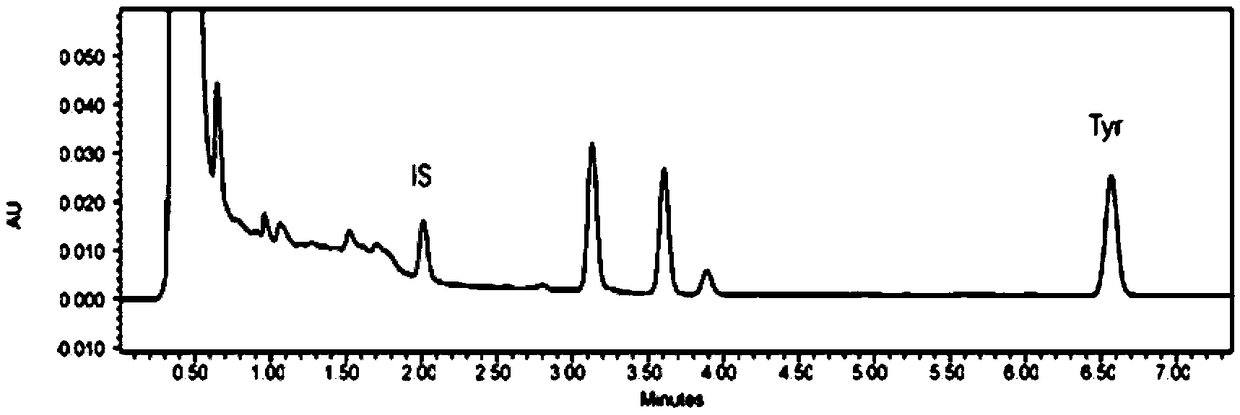Detection method of content of tyramine in fermented vinegar
A detection method and technology for fermenting vinegar, which can be applied to measuring devices, instruments, scientific instruments, etc., can solve problems such as difficult operation, complicated pretreatment steps, etc., and achieve the effects of low detection limit, simple and convenient sample analysis, and simple processing process.
- Summary
- Abstract
- Description
- Claims
- Application Information
AI Technical Summary
Problems solved by technology
Method used
Image
Examples
Embodiment 1
[0021] (a) Pretreatment of sample solution: Take 10.0 mL of fermented vinegar and dilute it with deionized water 5 times, filter with 0.22μm microporous membrane; store the filtrate at 4°C for later use.
[0022] (b) Derivatization reaction of the sample: Take 100μL of the sample from the filtrate and add 2.0μg·mL -1 100μL of internal standard solution, followed by 100μL of saturated sodium bicarbonate adjusted to pH 10 with sodium hydroxide, 5.0mg·mL prepared with acetone -1 200μL of dansyl chloride was derivatized at 55°C and protected from light for 15min. After the end, 100 μL of ammonia was added to stop the reaction for 25 minutes. Add acetonitrile to make up to 1.0mL. 0.22μm microporous membrane filter. The filtrate is tested on the column.
[0023] (c) UPLC detection conditions: Waters Acquity Ⅰclass ultra performance liquid chromatograph, C18, 2.1×50mm, 1.7μm chromatographic column, mobile phases of deionized water and acetonitrile, flow rate 0.3mL·min -1 , UV detection ...
Embodiment 2
[0028] (a) Pretreatment of sample solution: Take 5.0 mL of fermented vinegar and dilute 20 times with deionized water, filter with 0.22μm microporous membrane; store the filtrate at 4°C for use.
[0029] (b) Derivatization reaction of the sample: Take 100μL of the sample from the filtrate and add 2.0μg·mL -1 100μL of internal standard solution, followed by 100μL of saturated sodium bicarbonate adjusted to pH 10 with sodium hydroxide, 3.0mg·mL prepared with acetone -1 200μL of dansyl chloride, derivatization reaction was performed at 50°C in the dark, and reacted for 20min. After the end, add 100 μL of ammonia to stop the reaction for 30 minutes. Add acetonitrile to make up to 1.0mL. 0.22μm microporous membrane filter. The filtrate is tested on the column.
[0030] (c) UPLC detection conditions: Waters Acquity Ⅰclass ultra performance liquid chromatograph, C18, 2.1×50mm, 1.7μm chromatographic column, mobile phases of deionized water and acetonitrile, flow rate 0.3mL·min -1 , UV de...
Embodiment 3
[0035] (a) Pretreatment of sample solution: Take 2.0 mL of fermented vinegar and dilute 50 times with deionized water, filter with 0.22μm microporous membrane; store the filtrate at 4°C for later use.
[0036] (b) Derivatization reaction of the sample: Take 100μL of the sample from the filtrate and add 2.0μg·mL -1 100μL of internal standard solution, then add 100μL of saturated sodium bicarbonate adjusted to pH 10 with sodium hydroxide, 2.0mg·mL prepared with acetone -1 200μL of dansyl chloride was derivatized at 60°C and protected from light for 10min. After the end, 100μL of ammonia was added to stop the reaction for 20 minutes. Add acetonitrile to make up to 1.0mL. 0.22μm microporous membrane filter. The filtrate is tested on the column.
[0037] (c) UPLC detection conditions: Waters Acquity Ⅰclass ultra performance liquid chromatograph, C18, 2.1×50mm, 1.7μm chromatographic column, mobile phases of deionized water and acetonitrile, flow rate 0.3mL·min -1 , UV detection wavelen...
PUM
 Login to View More
Login to View More Abstract
Description
Claims
Application Information
 Login to View More
Login to View More - R&D
- Intellectual Property
- Life Sciences
- Materials
- Tech Scout
- Unparalleled Data Quality
- Higher Quality Content
- 60% Fewer Hallucinations
Browse by: Latest US Patents, China's latest patents, Technical Efficacy Thesaurus, Application Domain, Technology Topic, Popular Technical Reports.
© 2025 PatSnap. All rights reserved.Legal|Privacy policy|Modern Slavery Act Transparency Statement|Sitemap|About US| Contact US: help@patsnap.com



